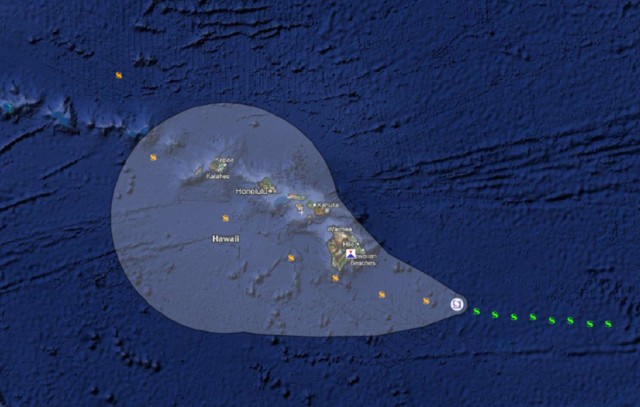SCHOFIELD BARRACKS, Hawaii Aca,!" We live in an era of persistent conflict; global terrorism and extremist ideologies threaten our safety and freedom.
This increased use of asymmetric tactics and the potential for natural crises such as pandemic influenza, hurricanes, tornadoes and flash floods demonstrate the need for every member of our Army community to be prepared for any emergency.
Col. Matthew Margotta, commander, U.S. Army Garrison-Hawaii, recognizes the full spectrum of threats facing our installations, information and people in the 21st century.
USAG-HI's Emergency Management program protects Soldiers, families, Army civilians and contractors from all hazards. It enhances mission assurance by providing policy, guidance and resources to deliver a comprehensive, integrated emergency preparedness capability to Army Hawaii.
Emergency preparedness starts with awareness. Research shows that most Americans do not prepare for a potential emergency because of factors such as complacency, denial, time and perceived cost.
Research also shows that military families are no more prepared than the rest of the population.
Margotta and the Directorate of Plans, Training, Mobilization and Security enhance emergency preparedness by conducting joint exercise drills that test the garrison directorates, Soldiers, families, Army civilians and contractors against such crises.
To prepare for the hurricane season, June 1-Nov. 30, USAG-HI will participate in Hawaii's annual hurricane exercise, "Makani Pahili," or "Strong Winds."
Makani Pahili is a joint exercise that involves the Hawaii and all armed services in the Hawaiian Islands. All directorate agencies will be tested on their capabilities that support the installation in a crisis.
Directorate agencies will be required to facilitate emergency operations in the USAG-HI emergency operations center over a two-week period, which started Thursday and ends June 4.
Ready Army
"Ready Army" is the Army Emergency Management program's proactive community awareness campaign to increase the resilience of the Army community by informing of relevant hazards and encouraging Soldiers, their families, Army civilians and contractors to "Get a Kit. Make a Plan. Be Informed."
To provide the best possible resources, the Army is the first service to formally partner with the Department of Homeland Security's national "Ready" campaign. The campaign expands the preparedness message to meet the unique needs of Soldiers and families, worldwide.
Ready Army fact sheets, posters, booklets, press kits and multimedia resources cover 25 diverse man-made and natural threats.
Ready Army also provides information on requirements and resources specific to the Army, including the Army Disaster Personnel Accountability and Assessment System, or ADPAAS.
The information about ADPAAS is designed to save lives and mitigate the effects of a catastrophic emergency acting as a time and resource multiplier for emergency first responders and medical first receivers.
Ready Army also provides peace of mind for our deployed Soldiers who must maintain their mission focus under all circumstances.
Visit the <a href="http://www.ready.army.mil">Ready Army website</a> for more information.
Hurricanes in Hawaii
Hurricanes, or tropical cyclones, are also known as typhoons, tropical storms, cyclonic storms, and tropical depressions.
<object width="500" height="405"><param name="movie" value="http://www.youtube.com/v/uLw-l4-pYR4&hl=en_US&fs=1&rel=0&color1=0x3a3a3a&color2=0x999999&border=1"></param><param name="allowFullScreen" value="true"></param><param name="allowscriptaccess" value="always"></param><embed src="http://www.youtube.com/v/uLw-l4-pYR4&hl=en_US&fs=1&rel=0&color1=0x3a3a3a&color2=0x999999&border=1" type="application/x-shockwave-flash" allowscriptaccess="always" allowfullscreen="true" width="500" height="405"></embed></object>
Tropical cyclones are areas of warm air and low pressure that rotate in a counterclockwise direction in the northern hemisphere.
Hurricanes and typhoons are tropical cyclones in which the wind velocity exceeds 74 mph, or 118 kilometers per hour. Such systems are accompanied by heavy rain and tornadoes. They often produce flooding and abnormally high tides called storm surges.
Hurricanes form over areas of warm ocean. Hurricanes that approach and occasionally pass over Hawaii are usually generated to the west of the lower Baja peninsula of Mexico.
Some hurricanes begin their lives off the coast of Africa and manage to cross Central America, regaining strength in the Pacific Ocean. They all move in a generally westward direction.
Because hurricanes make many turns along their path, it's difficult to predict where they will go next. Weather satellites and flights by specially equipped aircraft have made prediction considerably more reliable.
Hurricanes occasionally reach the Hawaiian Islands. The most recent powerful hurricane to reach Hawaii did serious damage to the island of Kauai. The hurricane was named "Iniki," a Polynesian word meaning, "a sharp and piercing wind."
(EditorAca,!a,,cs Note: Joe Barker is the installation management emergency officer.)


Social Sharing